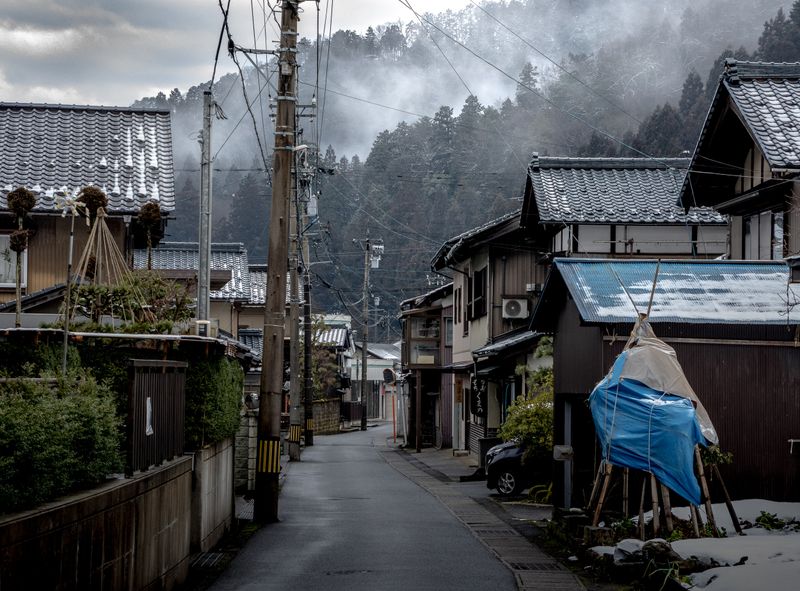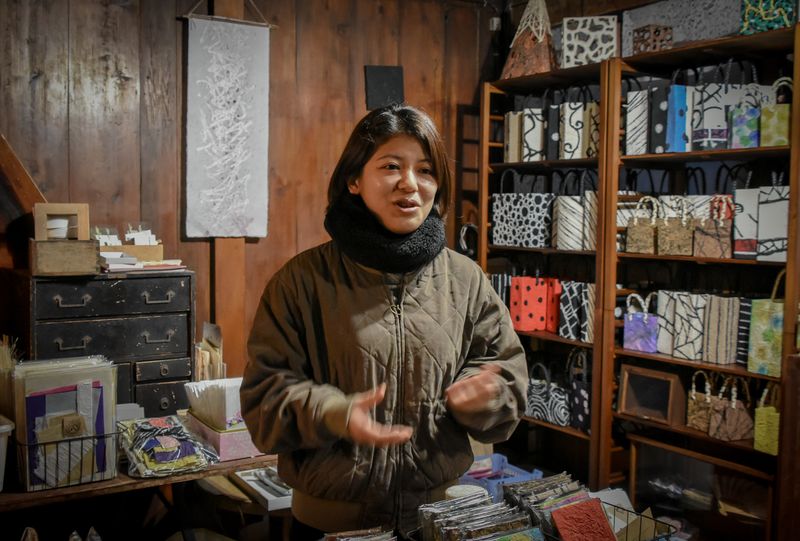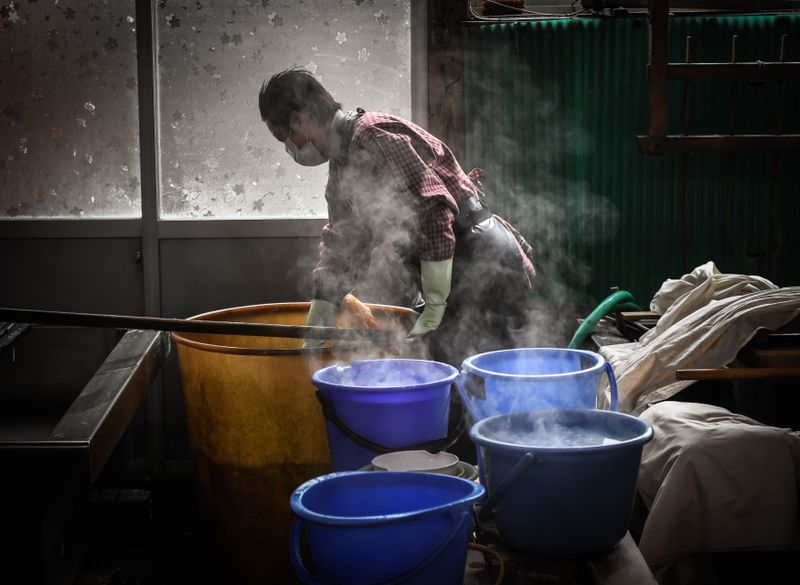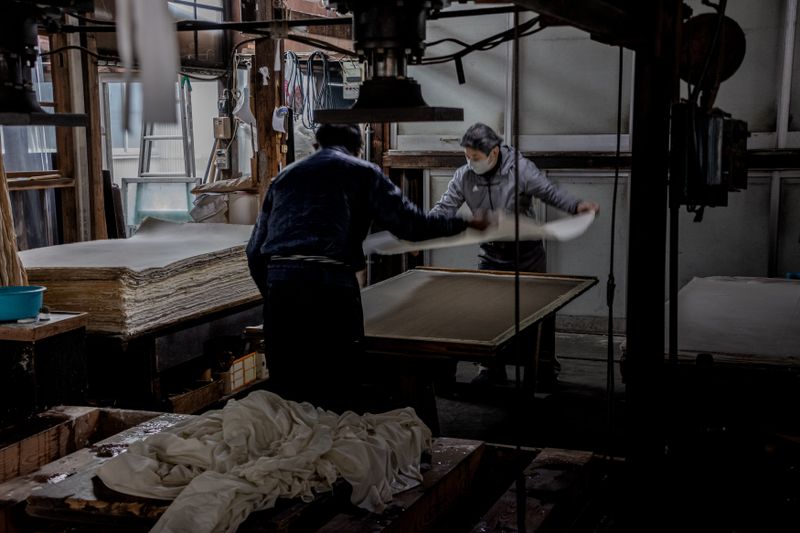May 31, 2021
Young papermaker gets creative to capture essence of Echizen washi
Gallery - Echizen washi, Fukui Prefecture

With lifestyle changes presenting an uncertain future for the industry and tradition of “washi” papermaking in Fukui Prefecture’s Echizen region, one young creative is developing new ways to capture the essence of the rich tradition in order to find it a new audience.
Almost every story about Echizen washi starts with a line about its 1500 years of history. There’s even a legend to go with it explaining the origins of how this traditional papermaking culture took root in central Japan’s Fukui Prefecture.
The legend is one about a young woman who appeared upstream along a river near to the village of Otaki (in present-day Echizen) and taught papermaking skills to the local people before disappearing. The mysterious young woman was given the name “Kawakami Gozen” and is worshiped as the Goddess of Papermaking at the local Okamoto Otaki Shrine to this day.
Lines about the history and legend of Echizen washi make for more than just convenient scene-setters, though. They describe the atmosphere of a collection of five villages (Oizu, Iwamoto, Shinzaike, Sadatomo and Otaki), located east of central Echizen City, that forms the beating heart of Echizen washi production.
Home to around 45 largely family-run businesses involved with the papermaking industry, the area of narrow streets and traditional paper mills feels saturated with a sense of history and legend which is amplified by the moody mountain slopes that frame the area. Here the skills and techniques of Echizen’s papermakers have evolved through generations.

(Okamoto Otaki Shrine where Japan’s only Goddess of Papermaking is enshrined)

(The streets of the Echizen washi production region, Fukui Prefecture)
“The history runs deep here. Washi has a history going back around 1500 years and a really strong culture has been created from that,” local papermaker Izumi Osada told City-Cost during a visit to the area in March. According to Osada, the handmade washi produced here accounts for around 20 percent of the market share in Japan, making it the country’s largest production center for handmade washi.
Despite this position of comparative strength, Echizen’s culture of papermaking has been put to the test in recent years.
Once described as the “King of Paper,” and having been the paper of choice for Japan’s elite since the 14th century, after around 1500 years annual sales of Echizen washi reached a peak of around 9.34 billion yen in 1990. It has taken just two decades, however, to see these sales reduced by two thirds to around 3 billion yen. Lifestyle changes are largely behind the decline with a decrease in demand for fusuma -- large sheets of paper used in sliding doors to partition houses -- among the main factors.
Papermakers like Osada, who works for the family-run business Osada Washi Co., Ltd., have been calling upon their strong sense of culture in efforts to revive industry fortunes by seeking to extend the appeals of Echizen washi to the wider public.
“People aren't aware of the scale of this production area, or the variety of its output and how interesting it can be. Even people in Fukui,” said Osada.

(Izumi Osada talks Echizen washi in the front office of the Osada Washi facility)
Despite being brought up around the family papermaking business (if not entirely immersed in it -- “When I was young I wasn’t even allowed to enter the factory area!”) Osada (29) chose a career in the travel industry following graduation from university in Kansai. After more than three years based in Tokyo, and traveling overseas for work, Osada returned home in 2018.
“At university we did seminars where we looked at the development and marketing of traditional Japanese confectionery. I felt like product development was quite interesting and something that could be done under your own initiative. I began to wonder if this was something I could do if I were to return home in the future.”
Indeed, following her return to Echizen, Osada began developing earrings featuring washi during her first year with the family business.
“There hadn’t been many people doing that until now, exploring these kinds of interesting ways to make use of washi. I like it when we're able to use our ingenuity to create and offer new styles of washi,” she said.
Osada’s creativity with washi has seen her invited to run a number of workshops giving people the chance to create their own washi-based products. During one workshop held at an event in the flagship store of the Muji brand in Tokyo’s fashionable Ginza district in 2020, participants had the chance to make their own earrings using washi.
“People were surprised. They had never seen accessories like this made from washi,” Osada said, describing feedback from the workshop.
“The paper I brought with me was “fusuma kami” which is quite thick and wrinkled. People asked me many times whether or not it was actually paper. They were surprised to see this kind of material.”
Some people may also be surprised to see the place where Echizen’s traditional paper is made. The Osada Washi production facility (established in 1904) feels a world away from glitzy Ginza. Here among the lumps of pulp and steaming buckets of liquid designer shoes are swapped for sturdy rubber boots, coordinated outfits for durable overalls and warm jumpers.

(On the production floor of papermaker Osada Washi, Echizen, Fukui Prefecture)

(On the production floor of papermaker Osada Washi, Echizen, Fukui Prefecture)
When she’s not creating new products with washi (as well as handling admin and communicating with customers, among a variety of tasks) Osada spends time on the factory floor often involved in the production of the large sheets of fusuma paper (using a process called "nagashi-zuki" in which a sheet of paper is created by dipping a mould into a paper-fibre solution and draining it off in a see-saw motion).
While the majority of Echizen’s papermakers are these days involved in the production of paper for walling and wrapping, according to Osada, a proud local boast says that there isn’t a kind of washi that can’t be found in Echizen.
The same boast may also present Echizen with its own stumbling block when it comes to reaching new audiences, making it harder for the industry to establish a clear identity in the minds of the wider public. Add to this 1500 years of history and legend telling of a mysterious goddess and the newcomer has a lot to digest.
“We've got all these papermakers here in the largest production region in Japan and I thought we should have something through which we can showcase this. I thought it would be good if we had a product which anyone could easily make use of,” Osada said.
The result of this idea is Osada’s “Torinoco” notebooks, named after a type of washi, the covers of which are made using paper created by local papermakers. Changing covers allows Osada to showcase different styles of washi, which can vary, including in thickness and texture, between papermakers.

(Above and top - “Torinoco” notebooks)
“The notebook allows us to put all of these elements into a single item. Also, with something like a notebook, which can be used and carried around every day, I wondered if this could create a greater attachment to washi,” Osada said.
Osada’s notebook project received a boost in 2020, taking out an award of financial support in a prefectural run contest gathering plans which propose local revitalization solutions.
Similar to previous workshops, the notebooks have also been showcased at an event in which participants could choose from 100 different kinds of covers to make their own torinoco notebooks.
“People said they really enjoyed putting together their own original notebooks, which felt good to hear.”
Osada, however, remains level-headed about any early successes of her endeavors.
“In terms of the sales generated from these small goods and what that can give back to the industry, it's difficult when I'm doing it alone and so I don't think it has that much impact,” she said.
“If we can do workshops like we did at Muji, then maybe we can do similar things or hold larger washi exhibits at other locations. Opportunities like this can have a positive impact on the industry.”
“I think the fact that washi is still being made here today is a testament to the amazing spirit of the local people,” Osada said when pressed into a message for those unfamiliar with Echizen washi.
“It would be great if people could see, touch, and use these different types of washi.”
In this way, Osada and other papermakers can perhaps let the washi do the talking, so to speak. What better way to express the 1500 years of history and the legend behind the tradition of Echizen washi?
Find more of Osada's products at the Osada Washi online store: https://osadawashi.stores.jp/
Visitors to the Echizen region can get an introduction to the history and culture of Echizen washi at the Echizen Washi Village. The village is home to a collection of facilities that includes a museum and workshop facilities offering papermaking experiences.



0 Comments